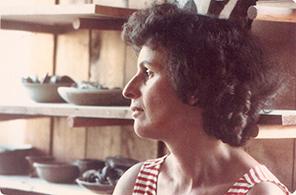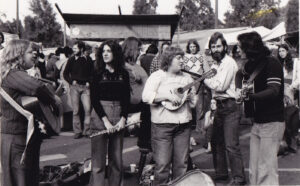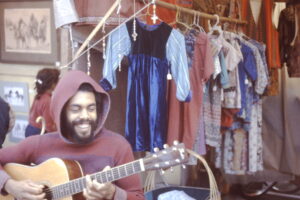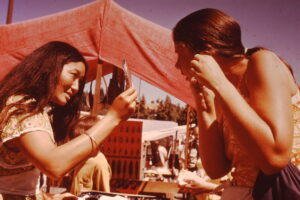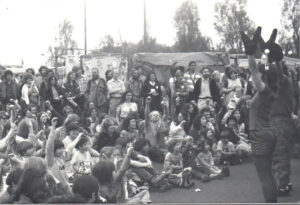SATURDAY MARKET: A Historical Perspective
The following article was originally written by Saturday Market founder Lotte Streisinger in April 1974, three years after the Market first opened. The text was revised in 1975, 1982, and 1984, after which time it was left alone. It stands as a useful description of the Market’s early years and principle values. Although many of the details have changed in the years since 1984, most of the images presented here still ring true. (Bill Goldsmith, 1995)
Introduction
Every Saturday, rain or shine, between April and Thanksgiving, approximately 150 vendors [200-250 in 2022] display their handmade or home-grown products in a park in downtown Eugene, Oregon, The sellers arrive early in the morning and set up their own individual booths. Buyers start to come around 10 AM, and from then on throughout the day the Market is alive with activity: browsing, buying, selling, trading, exchanging information, meeting friends, eating lunch, listening to and playing music. All these and more activities are going on simultaneously. Children and older people alike enjoy the selling and visiting at the Market. There is a true mixture of ages, incomes and lifestyles meeting with ease and pleasure.
Early History
In early 1970, there were three main factors which impelled us to this venture: (1) a large number of artisans and a lively interest in buying and using local crafts, as shown by the burgeoning success of annual Christmas craft sales, (2) an abundance of local produce and no downtown outlet since the closure of an old Farmers Market in the 1950’s, and (3) a dying downtown in need of revitalizing. Lotte Streisinger, a local potter, attended a Worlds Crafts Conference in Peru, and during the weekend visited the local marketplace and decided that something of that nature was needed in Eugene.
Once the notion of a Saturday Market had been conceived, letters were written to the Mayor and members of the City Council proposing the idea and asking for support. The Mayor appointed a committee which eventually recommended a site and made a proposal. it was considered essential that the site be: (1) on public property, (2) outdoors, (3) downtown, and (4) aesthetically pleasing. Such a site was located adjacent to a city-owned parking structure, and it was proposed that the City Council give its permission for one Saturday Market, after which the situation would be reviewed. This proposal was accepted, after two readings by the City Council, and over some objections from downtown businessmen. The news spread via the local media and by word of mouth, and on May 9th, 1970, the Saturday Market opened, in rainy weather, with a volunteer co-ordinator and 29 vendors. Each vendor was charged $1.00 to cover expenses, although it was not yet known precisely what these expenses would be. After reviewing the first Saturday the City Council extended permission for use of the site through the summer. In September, and in spite of considerable objection from some of the downtown business community, permission was extended until (and only until) Christmas.
It should be mentioned here that the Market had gone through some discouraging summer doldrums. The media had lost interest, many customers had gone away for vacation, and the number of vendors had dropped to 12 on one Saturday. Twelve vendors are not enough to make a Market, and it seemed that it might fade away. Some energetic publicity and determination at this point turned the tide and the Market began to grow.
The first season of the Market closed the last Saturday before Christmas, 1970. Some hundred vendors attempted to squeeze into the original space. it was a good day, despite over crowding and tension. It was also an indication that the Market’s future problems would center on its phenomenal growth.
The Market had become sufficiently well known enough that during the winter considerable energy had to be spent pointing out that various indoor events being promoted under the same name were not The Saturday Market. It was intended to re-open-the market the first Saturday in May. This May to December pattern followed for several years until 1975 when the pattern became April through Christmas.
Growth
By Christmas, 1970, merchant opposition, especially from those businesses which fronted the Market, had become vociferous. The Market had outgrown its site, its loosely organized structure, and its welcome. It was obvious that a new site, and a more organized structure of decision-making was needed.
During the winter 1970-71, the task of reorganization and finding a new site were undertaken by the five most actively involved market organizers. These five constituted the first Board of Directors (which has since been expanded to nine members). Up to this point, the Market had been managed by a rotating group of volunteers, but now it was recognized that a paid Manager and Assistant Manager must be employed. The search for a larger site, not on the doorstep of a business, led to the County government, which owned a good deal of property in downtown Eugene, the county seat. The Board Of Directors was now dealing with the County Commissioners instead of the City Council. This was a wholly new political situation. The commissioners required that the Market incorporate before they would begin discussions, and then that it got liability insurance. Both of these were expensive items–about $500 for Incorporation and lawyers fees, and about $800 for insurance for a year. (This latter cost has since been increased to about $2000 per year. We have never yet filed a claim). Fortunately, the dollars which had been collected from the vendors (this fee had been lowered to $.50 during the summer doldrums), had accumulated, but in any case the financial structure of the Market also needed to be revamped.
Many difficulties and political maneuvers accompanied the securing of the Market’s second site, a beautiful plaza in front of the County Courthouse. The Market was only permitted to stay there for the summer, after which it was required to move to the upper level of a county-owned, tree-surrounded, two-level parking lot across the street. The Saturday Market remained in this location until November 1982.
In 1978 a County Task Force was initiated to study the feasibility of starting a new Farmer’s Market to provide a place where local growers and producers could sell their goods directly from their trucks to the public. The Saturday Market offered to provide the administration, organizational structure, insurance and marketing. expertise to make it happen. In August 1979, the first Farmer’s Market in 25 years opened in a site directly adjacent to the Saturday Market and, coincidentally, in the same site where the first Eugene Farmer’s market opened 64 years before. The Farmer’s Market has been very popular with the community and operates regularly from July through October. While it has not proven a financial success for Saturday Market, it is an important community service, and it has expanded the number and variety of our clientele.
- Lotte Streisinger
- Mithrandir
- Tricycle Parade
- Busking
- Jewelery At the Market
- Vaudeville
Challenges
The major problems encountered by the Saturday Market, and which might be expected by Markets starting in other communities can be gathered under the headings: (1) slow start, (2) business opposition, and (3) internal strife and growth.
Slow Start: As mentioned above, a new Market may be expected to have some slow discouraging times after the excitement of its opening has worn off. It is very important to maintain faith and persistence at this time, and also, perhaps, to launch some imaginative publicity. For example, in our case, a stilt-walker with a sandwich board advertising the Market was hired to walk up and down the main street, and the local newspaper put his picture on the front page of the Sunday edition.
Business Opposition: From its inception, the Market has encountered some opposition from downtown merchants and from those elected officials who represent the business community. It was four or five years before this negative pressure generally disappeared. Primarily, there were those merchants on whose doorstep we were first located. They feared, perhaps legitimately, that their customers would be kept away by the crowded confusion of the Market. Obviously, it is preferable to find a site which is not directly in front Of established businesses. Secondly, there was the fear of business competition from the market itself. On the whole, however, the types of wares sold at the Market are not the same as those sold in regular stores. Furthermore, a statistical study of shoppers at the Market has shown that the Market is actually good for downtown business, attracting many shoppers who would otherwise not have come into town, people who came because of the Market, and who then go on to shop in the stores. Other Markets have been started in Oregon communities under the auspices of the local Chambers of Commerce or downtown business associations.
Occasionally the Market is criticized for not paying downtown taxes. However, the Market occurs only once a week, it is a not-for-profit organization and basically a community attraction and event; located just outside the taxable boundaries.
Finally, the Market has been the object of some resentment because it represents a deviation from the usual form of retail merchandising in the U.S. It does indeed, and we think this is one of the Market’s greatest strengths. Here you get to meet the person who made the object you are buying. You can find out how they made it, you can bargain, or perhaps put in a special order. It is a totally different shopping experience than in the usual supermarket or department store, and most people, once they get used to it, really like it.
Internal Strife and Growth: The Market has had recurring problems of internal conflict over the necessity for rules and over the direction of its growth. Some Market vendors have felt that the world of rules and regulations are just what they are trying to get away from and that the Market shouldn’t have restrictions of any sort. The Marketeers find it necessary to establish rules, but we try to keep them to a minimum.
One rule, which became a recurring problem with the growth of the Market, was that booths should not be set up before 6 a.m. (when the Market had jurisdiction over the lot). Vendors began getting to the Market place earlier and earlier on Saturday in order to secure a particular spot, and there were some conflicts over favored spaces. In 1974, the Market decided to meet this problem of space competition with a lottery system of weekly random space allotment. There was room for about 225 8’x8′ booths. Those vendors unable to get spaces one week got first priority for the following Saturday. In subsequent votes of the Market Community, the lottery was retained until the 1978 season when attendance and vendor competition had leveled out and enough spaces were available for all. The problem of space competition was allied with the problem of limited space for selling. There was just not enough room for all the people who wished to sell at the market to set up every Saturday. Since a substantial number of vendors depend on the Market for the whole or greater portion of their yearly income, limiting their selling days presented them with a severe economic problem. Some vendors backed plans to institute priority, seniority or judging systems for selling at the Market, thus insuring them a weekly space. In 1974, a Sunday Market was instituted to give vendors an additional selling option. The Sunday Market never attained the popularity of The Saturday Market and was not the expected relief valve for the Market’s growth problems. Regular Sunday Markets were discontinued in 1976 and now only happen for special events. In 1981 the first special five-day Christmas Market was tried with limited success, perhaps due to some especially calamitous December weather.
Another more subtle problem associated with growth was a loss of community spirit within the Market. It used to be the Market against the world–a tight little group fighting together to prove the worth of an idea. When the Market became bigger, more successful and accepted, many vendors came on Saturday mornings and left in the evening without feeling particularly involved in the organization. The Board works to keep communication open through the Market newsletter and by urging people to come to Saturday Market Board and Standards Committee meetings, which are held two evenings of every month. Occasionally, there are short meetings on the Market site at 9:00 or 9:30 on a Saturday morning. Such meetings serve to pass out information but are not suitable for decision making.
Basic Principles of the Market
There are two basic principles which the Market Board considers most important and which it has decided to require of any other group in Oregon desiring to use the term “Saturday Market” in any form. Eugene has pre-empted the name “Saturday Market” for the State of Oregon. Other communities wishing to use the name will have to prefix it with their name, e.g., “the Medford Saturday Market.” Even so, they must get permission from the Saturday Market Board, which will require that the following two conditions be met: (1) that the Market organization is non-profit, i.e., that none of the Directors gain any profit from the running of the Market, and (2) that everything sold at the Market is made, grown or gathered by the person selling it (or a family member or partner). This means that there are to be no imported or second-hand goods, thus insuring the direct relationship between the maker and the buyer. Generally, the Market staff and the other vendors are able to decide quite easily whether a certain item is locally handmade or not. In the event of a doubtful situation, the vendor is usually told that he/she may stay that particular Saturday, but must come to a Standards Committee meeting before selling again. The Standards Committee was formed in 1981 to set up craft guidelines and to resolve questions and disputes.
In addition to the above two basic principles of the Market, there are a number of others which are considered important:
(1) Outdoors: The open-air quality of the Market is an essential ingredient in its success. it makes it beautiful, free and varied with the weather. It has encouraged the vendors to construct imaginative, weatherproof, individual booths which are a colorful and lively addition to the downtown area. Also, because there is no door to open and no building to enter, a hesitant first-time visitor is able to look the situation over before plunging in.
(2) Downtown Location: The Board has always felt it essential to be centrally located, both to enhance the downtown, and to enable people to walk, bicycle, ride the bus or push carts to the Market. In accordance with ecological principles, we have attempted to emphasize means of transportation other than the car for getting to the Market. With the surge of Market growth, both parking for vendors and restrooms for the public had been problems. Site planning should take these into consideration.
(3) Public Property: All three of the Market’s sites so far have been on public property and we hope to continue in this way. it is felt that the Market is a public service, and the Oregon Constitution recognizes this fact by permitting counties to set up public markets and even to spend money for this purpose if necessary. The association with public bodies has also, of course, helped the Market to attain general acceptance in the community.
(4) Aesthetics: The Saturday Market is beautiful to look at and this is not entirely by accident. We have consistently tried to find a site which has some trees and greenery, some shielding from traffic, some interesting design, etc. Of course, this is not always easy to attain, but it is important. Also, everything associated with the Market’s public image–the information booth, benches, signs, posters and stationery have all been carefully chosen for good workmanship and beauty of design. This caring attitude is contagious; many vendors who simply spread their wares on a blanket at first have since constructed excellent booths for display.
(5) Winter Closure: The Saturday Market closes from the last Saturday before Christmas to the first Saturday in April. The weather is terrible in Eugene during this period, and there are no fruits, vegetables or flowers, which constitute an important aspect of the market. There are also positive benefits in this winter closure: the craftspeople have a time to rest, to improve their product and to make and design new things. In addition, the reopening of the Market in the spring becomes a big event. Everyone looks forward to it and the media gives it a lot of free publicity.
(6) Non-juried: There are few quality criteria (and no seniority system) for selling at the Saturday Market; anyone who has made something has the same right to sell it at the Market as anyone else. As of 1981, guidelines were written to reflect more detailed standards for what is actually considered handcrafted.
Organization of the Market
Policy decisions for the Saturday Market are made by the Board of Directors with the help of the Saturday Market Standards Committee and Budget Committee. The Board consists of nine members elected by the Committee. Each member serves for 18 months and may be reelected once. Three new Board members are selected every six months so that the membership rotates, and there are always some old and some new members. It is desirable to have the Market vendors as well. as the community at large represented on the Board. There is a Board Executive Director elected by the members for one year, and a Treasurer.
The Board continues to meet during the winter when the Market is not in session. it hires the staff, which at this writing-consists of a Director, Administrative Assistant/Financial Coordinator, Promotions Coordinator, one Saturday Worker and two set-up/take-down workers, and the Farmer’s Market Manager. The Board also sets the salary for the staff, a budget and fee schedule, as recommended by the Budget Committee. The Standards Committee generally decides whether questionable items may or may not be sold at the Market.
The general philosophy is that a strong staff is essential to the continued growth of the organization. A commitment towards maintaining quality staff members is indicated by the Board’s offer of a two-year contract to the present Director, a position which has always been on a one-year basis. The Director is in overall charge of carrying out Market policy, particularly in relation to the community at large. Intent to offer salaries which are more in line with maintaining a strong staff has been a priority of the Board in more recent years.
Christmas of 1981 was our first week-long Market. Much advertisement went into this special event. Extreme bad weather resulted in low attendance for both vendors and customers.
April 1982, our thirteenth Season, business started out better than it had ended at Christmas. By the end of the first month of operation the Market had recovered from the debts left from its disastrous Christmas week. But before the marketeers had a chance to celebrate being in the black, on May 2 an arsonist set fire to all the Market’s operational equipment, including information kiosk, stages, tarps, banners and signs. Insurance didn’t cover the losses which were total, as the equipment was stored in an open area in the basement of the parking lot. Unable to store equipment there any longer, the Market bought its first vehicle, a 1948 1/2 ton flatbed truck on which it stores all its equipment, in a garage site which is locked and insured. With limited funds to advertise, due to additional expenses to recover from the fire, both vendor and customer population began to dwindle. As the year went on, overall vendor count dropped to an all time low. The parking lot looked too big for the number of participants.
The Market worked with the city and county representatives to relocate to the Park Blocks at 8th & Oak, the current location, where the space looks filled with 100-125 vendors (it took 200-250 to fill the parking lot). We currently approach capacity on most days, the site is very attractive, much more visible to traffic, and vendor count is increasing as well as vendor sales.
The Market’s Commitment to Equality
Saturday Market has always been a place of equality. We have been dedicated to providing a safe space for vendors and shoppers to convene every Saturday since our opening day in 1970. We stand in solidarity with the movement to end social injustice in our community and our country. We are part of a society where the lives of Black, Indigenous, and other People of Color continue to be blighted by structural racism, lack of opportunity, health care access disparities, and violence. We affirm our longstanding commitment to act in solidarity with those who are suffering from systemic inequity. Affirming that Black Lives Matter engages with our mission of recognizing the value and importance of diversity, and commits us to creating inclusive and equitable spaces where members and visitors can come together to enjoy a day at Saturday Market.
Conclusion
We who have worked with the Saturday Market in Eugene have found it an exciting and rewarding experience, and we would like to recommend it to other communities. The Market here is doing what we hoped–helping to revitalize the downtown area, bringing together makers and consumers of local crafts, as well as bringing locally grown fruits, vegetables, flowers and plants into town. In addition, the Market has done much more: it has fostered local pride and given a lot of people something exciting to do on Saturdays. It has justified the belief that the work of one’s hands is of value, and has encouraged the craftspeople to improve their product and its presentation. The Market is a great place for the exchange of information about how to do things, where to get supplies, etc. By selling at the Market, a number of people have been able to survive without applying for public assistance. Numerous businesses have started at Saturday Market and gone on to full time operations elsewhere in Eugene and, in many cases, throughout the United States.
The Market has become a meeting place for the whole community; it is where one meets friends, takes visitors, passes petitions, in addition, of course, to buying birthday and Christmas presents, and so on, Non profit community groups are able to disseminate information with free booth space provided. Quality entertainment has become much more of a focal point for bringing local residents back time and again. Craft demonstrations are becoming more a part of weekly attractions as the market strives towards providing an ongoing educational experience as well. The Market has had some influence on statewide legislation regarding the sale of baked goods. Members of the staff and the Board have been invited to talk to classes at the University of Oregon about various aspects of the market which concerns them, and the Market has been the subject of numerous high school and college term papers and architectural projects.
In Eugene the Saturday Market is now an institution. It enters casually into conversations: “I bought it at the Saturday Market;” “See you at the Saturday Market;” and (to a newcomer) “Have you been to the Saturday Market?” We think the Market has been good for our town and feel sure it could be good for others.
Support artisans here in Oregon! You can contribute to the Eugene Saturday Market, and help us support local artisans and micro-businesses. The Saturday Market is a not-for-profit and artist first organization. To get started click on the ‘Support the Saturday Market’ button.
You can also donate to the Kareng Fund: an Emergency Relief Fund for artists here in Oregon. The Kareng Fund is a 501(c)3 non-profit that supports artists, who have awarded over $100,000 in grants to artists in crisis. To donate and/or learn more about the Kareng Fund, click the ‘Support the Kareng Fund’ button.

